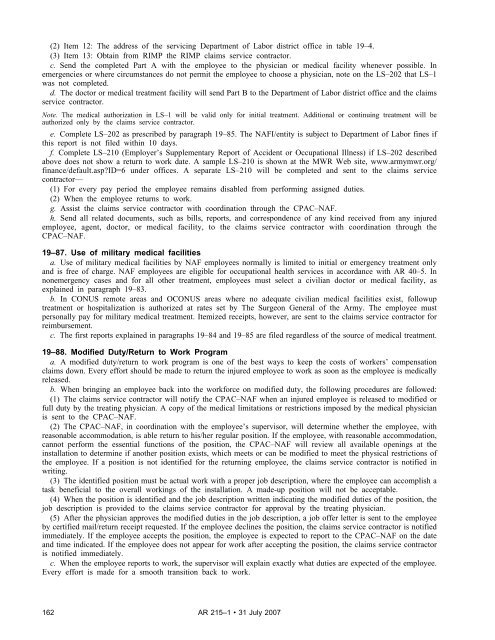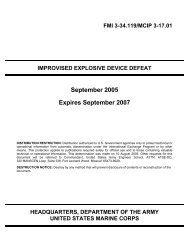AR 215-1 - Soldier Support Institute - U.S. Army
AR 215-1 - Soldier Support Institute - U.S. Army
AR 215-1 - Soldier Support Institute - U.S. Army
You also want an ePaper? Increase the reach of your titles
YUMPU automatically turns print PDFs into web optimized ePapers that Google loves.
(2) Item 12: The address of the servicing Department of Labor district office in table 19–4.<br />
(3) Item 13: Obtain from RIMP the RIMP claims service contractor.<br />
c. Send the completed Part A with the employee to the physician or medical facility whenever possible. In<br />
emergencies or where circumstances do not permit the employee to choose a physician, note on the LS–202 that LS–1<br />
was not completed.<br />
d. The doctor or medical treatment facility will send Part B to the Department of Labor district office and the claims<br />
service contractor.<br />
Note. The medical authorization in LS–1 will be valid only for initial treatment. Additional or continuing treatment will be<br />
authorized only by the claims service contractor.<br />
e. Complete LS–202 as prescribed by paragraph 19–85. The NAFI/entity is subject to Department of Labor fines if<br />
this report is not filed within 10 days.<br />
f. Complete LS–210 (Employer’s Supplementary Report of Accident or Occupational Illness) if LS–202 described<br />
above does not show a return to work date. A sample LS–210 is shown at the MWR Web site, www.armymwr.org/<br />
f i n a n c e / d e f a u l t . a s p ? I D = 6 u n d e r o f f i c e s . A s e p a r a t e L S – 210 w i l l b e c o m p l e t e d a n d s e n t t o t h e c l a i m s s e r v i c e<br />
contractor—<br />
(1) For every pay period the employee remains disabled from performing assigned duties.<br />
(2) When the employee returns to work.<br />
g. Assist the claims service contractor with coordination through the CPAC–NAF.<br />
h. Send all related documents, such as bills, reports, and correspondence of any kind received from any injured<br />
e m p l o y e e , a g e n t , d o c t o r , o r m e d i c a l f a c i l i t y , t o t h e c l a i m s s e r v i c e c o n t r a c t o r w i t h c o o r d i n a t i o n t h r o u g h t h e<br />
CPAC–NAF.<br />
19–87. Use of military medical facilities<br />
a. Use of military medical facilities by NAF employees normally is limited to initial or emergency treatment only<br />
and is free of charge. NAF employees are eligible for occupational health services in accordance with <strong>AR</strong> 40–5. In<br />
nonemergency cases and for all other treatment, employees must select a civilian doctor or medical facility, as<br />
explained in paragraph 19–83.<br />
b. In CONUS remote areas and OCONUS areas where no adequate civilian medical facilities exist, followup<br />
treatment or hospitalization is authorized at rates set by The Surgeon General of the <strong>Army</strong>. The employee must<br />
personally pay for military medical treatment. Itemized receipts, however, are sent to the claims service contractor for<br />
reimbursement.<br />
c. The first reports explained in paragraphs 19–84 and 19–85 are filed regardless of the source of medical treatment.<br />
19–88. Modified Duty/Return to Work Program<br />
a. A modified duty/return to work program is one of the best ways to keep the costs of workers’ compensation<br />
claims down. Every effort should be made to return the injured employee to work as soon as the employee is medically<br />
released.<br />
b. When bringing an employee back into the workforce on modified duty, the following procedures are followed:<br />
(1) The claims service contractor will notify the CPAC–NAF when an injured employee is released to modified or<br />
full duty by the treating physician. A copy of the medical limitations or restrictions imposed by the medical physician<br />
is sent to the CPAC–NAF.<br />
(2) The CPAC–NAF, in coordination with the employee’s supervisor, will determine whether the employee, with<br />
reasonable accommodation, is able return to his/her regular position. If the employee, with reasonable accommodation,<br />
cannot perform the essential functions of the position, the CPAC–NAF will review all available openings at the<br />
installation to determine if another position exists, which meets or can be modified to meet the physical restrictions of<br />
the employee. If a position is not identified for the returning employee, the claims service contractor is notified in<br />
writing.<br />
(3) The identified position must be actual work with a proper job description, where the employee can accomplish a<br />
task beneficial to the overall workings of the installation. A made-up position will not be acceptable.<br />
(4) When the position is identified and the job description written indicating the modified duties of the position, the<br />
job description is provided to the claims service contractor for approval by the treating physician.<br />
(5) After the physician approves the modified duties in the job description, a job offer letter is sent to the employee<br />
by certified mail/return receipt requested. If the employee declines the position, the claims service contractor is notified<br />
immediately. If the employee accepts the position, the employee is expected to report to the CPAC–NAF on the date<br />
and time indicated. If the employee does not appear for work after accepting the position, the claims service contractor<br />
is notified immediately.<br />
c. When the employee reports to work, the supervisor will explain exactly what duties are expected of the employee.<br />
Every effort is made for a smooth transition back to work.<br />
162 <strong>AR</strong> <strong>215</strong>–1 • 31 July 2007

















